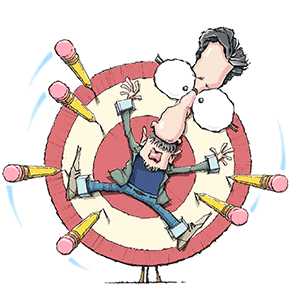My Pet World: How to get your dog familiar with car rides
Horwitz continues, "Teach Buddy to be calm and relaxed behind a closed door, and begin to teach her when only you (and/or family members) are home before you try this when company visits."
Certainly, it's fine to stuff cookies or low fat/low salt peanut butter or low fat cream cheese into Kong toys, or pour kibble into food puzzles or food dispensing toys to keep him occupied behind that closed door.
"Ultimately you'll want to desensitize and counter-condition Buddy to visitors, and you can do that," Horwitz says. It's best to find a dog trainer using positive reinforcement techniques or a veterinary behaviorist to meet your dog in person to assess the situation, and to show you what to do.
Q: My Australian Shepherd lies on her stomach to have her belly rubbed, then shortly after she takes a rear leg and starts to hit herself in the head just before her left ear. Is this a nervous tick, or is she trying to tell me something? -- C.T., Cyberspace
A: When dogs' bellies are rubbed, it's not unusual for one leg to move back and forth, over and over as a kind of reflex response. "But this seems more intense and vigorous," says Horwitz. "It would be interesting to offer much shorter belly rubs, and see if she asks for more. This may be like how it's OK to tickle someone for a few seconds, but not for many minutes -- it's no longer fun."
Clearly, you don't think this is normal. If you have a smartphone or videotape of the behavior, email it your veterinarian.
Q: We rescued a little 3 1/2-year old Jack Russell Terrier. She's a Dr. Jekyll and Mr. Hyde dog. When walking her, she gets aggressive with any dog that gets anywhere near us. My husband is getting frustrated and getting to the point of getting rid of her. She is a troubled little girl. Can you provide any help? -- S. S., St. Catharine's, Ontario, Canada
A: "Some dogs are more reactive than others, and terriers are right up there, sometimes bordering on dramatic," says Horwitz. "The technique (your dog is using) works; the dog gets aggressive, barking and all those antics -- and you walk away, the other dog walks away. So, your dog does it again and again."
Horwitz continues, "What you should do for now is to simply stay away from other dogs, so your dog doesn't continue to practice this behavior."
Horwitz suggests that a dog trainer who uses positive reinforcement techniques or a veterinary behaviorist is necessary to observe exactly what's going on, and then show you how you can help to lower your dog's level of reactivity, and demonstrate the right timing to do so.
As frustrating as this problem is, please don't give up your dog. Sent back to the shelter -- even if adopted out again -- this pup's chances might not be so good.
(c) 2015 DISTRIBUTED BY TRIBUNE MEDIA SERVICES, INC.






